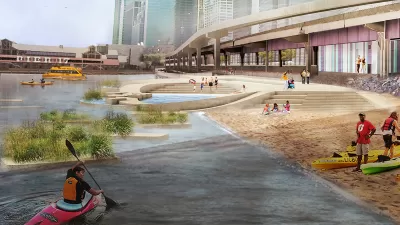With sleek high-rises, a waterfront promenade, and yacht-filled marina, Eko Atlantic could help Lagos attract the world's elite. But when it isn't busy demolishing their homes, what is the government doing to improve poor residents' quality of life?
"The state government in Lagos recently released a short, slick video touting Lagos as 'Africa’s Big Apple' which features shots of the glitzy artificial city, known as Eko Atlantic. The video also shows a parade of fast boats, traffic-free roads, glamorous hotel pools, and clothing boutiques," writes Alexis Okeowo. "Eko Atlantic underscores the worry among some Lagosians that their government wants to protect only the city’s rich from rising sea levels."
When the government isn't busy touting its "mega-city dream", it's evicting residents of shantytowns such as Makoko and burning the homes of "a community that lived on the fringes of Bar Beach."
“'The government has not done anything for us yet, so people are trying to improve the environment themselves, bettering their sanitation practices,' Afose Sulayman, a Makoko resident, said. Makoko’s residents lack access to clean water and endure endemic poverty. 'What people really want is the government to help them develop the community, instead of trying to take the land,' Sulayman added."
"Lagos, many say, has made progress in upgrading public services, roads, traffic lights, and green spaces, and is embarking on promising sustainable ventures," notes Okeowo. "Its new mini-city may be an example, attracting investment and tourism. But Victoria Island is only a fraction of the mushrooming metropolis. Will the rest of it be left behind?"
FULL STORY: A SAFER WATERFRONT IN LAGOS, IF YOU CAN AFFORD IT

Maui's Vacation Rental Debate Turns Ugly
Verbal attacks, misinformation campaigns and fistfights plague a high-stakes debate to convert thousands of vacation rentals into long-term housing.

Planetizen Federal Action Tracker
A weekly monitor of how Trump’s orders and actions are impacting planners and planning in America.

San Francisco Suspends Traffic Calming Amidst Record Deaths
Citing “a challenging fiscal landscape,” the city will cease the program on the heels of 42 traffic deaths, including 24 pedestrians.

Bend, Oregon Zoning Reforms Prioritize Small-Scale Housing
The city altered its zoning code to allow multi-family housing and eliminated parking mandates citywide.

Amtrak Cutting Jobs, Funding to High-Speed Rail
The agency plans to cut 10 percent of its workforce and has confirmed it will not fund new high-speed rail projects.

LA Denies Basic Services to Unhoused Residents
The city has repeatedly failed to respond to requests for trash pickup at encampment sites, and eliminated a program that provided mobile showers and toilets.
Urban Design for Planners 1: Software Tools
This six-course series explores essential urban design concepts using open source software and equips planners with the tools they need to participate fully in the urban design process.
Planning for Universal Design
Learn the tools for implementing Universal Design in planning regulations.
planning NEXT
Appalachian Highlands Housing Partners
Mpact (founded as Rail~Volution)
City of Camden Redevelopment Agency
City of Astoria
City of Portland
City of Laramie




























